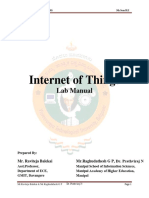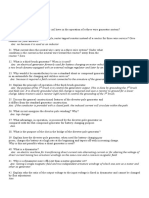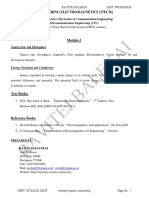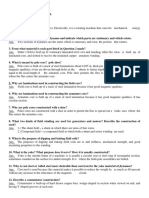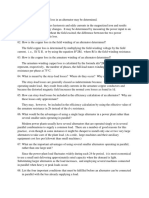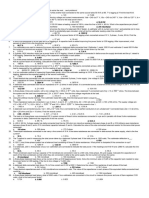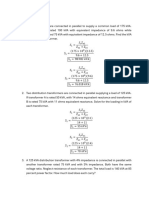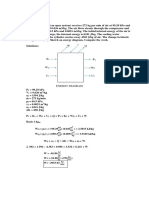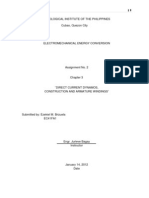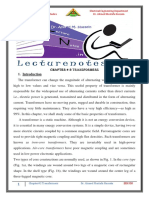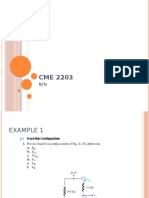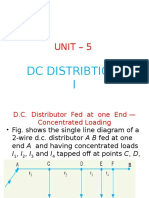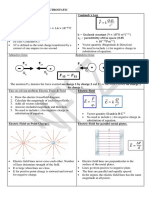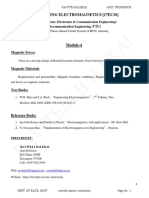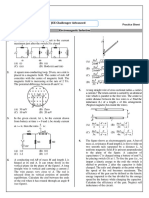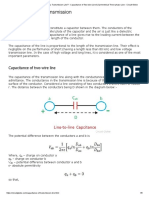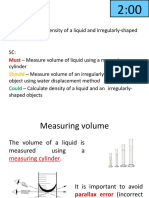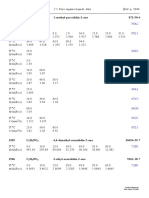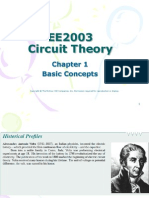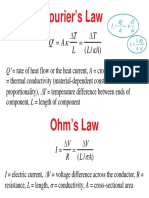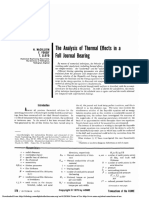Ee-Module 1 PDF
Ee-Module 1 PDF
Uploaded by
ravitejCopyright:
Available Formats
Ee-Module 1 PDF
Ee-Module 1 PDF
Uploaded by
ravitejOriginal Title
Copyright
Available Formats
Share this document
Did you find this document useful?
Is this content inappropriate?
Copyright:
Available Formats
Ee-Module 1 PDF
Ee-Module 1 PDF
Uploaded by
ravitejCopyright:
Available Formats
EE 17EC36 - MODULE - 1 RAVITEJ BALEKAI ASST.
PROFESSOR
ENGINEERING ELECTROMAGNETICS [17EC36]
B.E., III Semester, Electronics & Communication Engineering/
Telecommunication Engineering (VTU)
[As per Choice Based Credit System (CBCS) scheme]
Module-1
I
Coulomb’s Law, Electric Field Intensity and Flux density
A
Experimental law of Coulomb, Electric field intensity, Field due to continuous
K
volume charge distribution, Field of a line charge, Electric flux density.
LE
Text Books:
1. W.H. Hayt and J.A. Buck, “Engineering Electromagnetics”, 7th Edition, Tata
BA
McGraw-Hill, 2009, ISBN-978-0-07-061223-5.
Reference Books:
1. Ian John Krauss and Daniel A Fleisch, “ Electromagnetics with applications”, Mc Graw
EJ
Hill.
2. N. Narayana Rao, “Fundamentals of Electromagnetics for Engineering”, Pearson.
IT
PREPARED BY:
V
RAVITEJA BALEKAI
RA
Asst Professor
ECE Dept, GMIT
Davangere 577006
Cell: +919739223504
Mail: ravitejj10@gmail.com , ravitejb@gmit.ac.in
Website: https://ravitejb.wixsite.com/ravitej
DEPT. OF E&CE, GMIT ravitejb.wixsite.com/ravitej Page No - 1
EE 17EC36 - MODULE - 1 RAVITEJ BALEKAI ASST. PROFESSOR
Coulomb’s Law
The Coulomb’s law states that force between the two point charges Q1 and Q2,
1. Acts along the line joining the two point charges.
2. Is directly proportional to the product (Q1 Q2) of the two charges.
3. Inversely proportional to the square of the distance between them.
Consider the two point charges Q1 and Q2 as shown in figure separated by the distance R. The charge Q1
I
exerts a force on Q2 while Q2 also exerts a force on Q1 .
A
Q1 R Q2
K
Fig. 1
LE
Mathematically the force F between the charges can be expressed as, Fα
F=
BA
Where k= constant of proportionality =
= Permittivity of the medium in which charges are located (Absolute Permittivity) = 0 r
0= Permittivity of free space or Vaccum = 8.854 x 10-12 F/m
EJ
r = Relative permittivity
F=
IT
V
F2
Q2 a12
RA
R12
Q1 r2
r1 Origin
Fig. 2 Vector form of Coulomb’s law
DEPT. OF E&CE, GMIT ravitejb.wixsite.com/ravitej Page No - 2
EE 17EC36 - MODULE - 1 RAVITEJ BALEKAI ASST. PROFESSOR
The force exerted by Q1 on Q2 acts along the direction . Hence the force in the vector form can be
expressed as
Similarly, the force exerted by Q2 on Q1 acts along the direction . Hence the force in the vector form
can be expressed as
I
A
= N
=Unit Vector = =
K
[ Note: The force exerted by the two charges on each other is equal but opposite in direction
LE
- =- ]
BA
Force Due to N Number of Charges
If there are more than two point charges, then each will exert force on the other, then the net force on any
charge can be obtained by the principle of superposition.
Q1 R1
EJ
Q2 R2 Q
IT
Q3 R3
Rn
V
Qn
Fig. 3 F due to N number of charges
RA
Consider a point charge Q surrounded by n point charges Q1, Q2, Q3 …. Qn as shown in figure. The total
force on Q in such case is vector sum of all the forces exerted on Q due to each of the other n point charges
Q1, Q2 ,Q3 ….Qn.
F = F1 + F2 + F3 + ……… + Fn
DEPT. OF E&CE, GMIT ravitejb.wixsite.com/ravitej Page No - 3
EE 17EC36 - MODULE - 1 RAVITEJ BALEKAI ASST. PROFESSOR
F= + + + ………. +
F= N
Electric Field Intensity
Consider a charge Q1 as shown in figure
I
A
F2
K
Q2
+Q1
LE
BA
Fig. 4 Electric Field
There exists a region around a charge in which it exerts a force on any other charge. This region where a
particular charge exerts a force on any other charge located in that region is called electric field of that
charge.
EJ
The force experienced by the charge Q2 due to Q1 is given by coulomb’s law as,
IT
F2
V
The force per unit charge can be written as
RA
The force exerted per unit charge is called electric field intensity or electric field strength.
E2 = V/m
DEPT. OF E&CE, GMIT ravitejb.wixsite.com/ravitej Page No - 4
EE 17EC36 - MODULE - 1 RAVITEJ BALEKAI ASST. PROFESSOR
Electric Field at a point due to N number of charges
Consider n charges Q1, Q2, Q3 …. Qn as shown in figure. The combined electric field intensity is to
be obtained at point P. The distances of point P from Q1, Q2, Q3 …. Qn are R1, R2, R3 …. Rn respectively.
Q1 R1
Q2 R2 Q P
I
A
Q3 R3
Rn
K
Qn
LE
Fig. 5 E due to N number of charges
The total electric field intensity at point P is the vector sum of the individual field intensities produced by
the various charges at the point P.
BA
E = E1 + E2 + E3 + ……… + En
E= + + + ………. +
EJ
E= V/m
IT
Problems
1. A charge Q1 = - 20 µC is located at A(-6,4,6) and a charge Q2 = 50 µC is located at B(5,8,-2) in a free
V
space. Find the force exerted on Q2 by Q1 in vector form. The distances given are in meters.
RA
=-6 4 6 =5 8 -2
The force exerted on Q2 by Q1 = F2 ( 0 = 8.854 x 10-12 F/m )
= - = (5 – (-6)) + (8 - 4) (-2 - 6) = 11 +4 -8
= – = 14.1774 =
DEPT. OF E&CE, GMIT ravitejb.wixsite.com/ravitej Page No - 5
EE 17EC36 - MODULE - 1 RAVITEJ BALEKAI ASST. PROFESSOR
= = = 0.7758 + 0.2821 – 0.5642
F2 = -20 x 10-6 x 50 x 10-6 = - 0.0346 - 0.01261 + 0.0252 N
The magnitude of the force is,
= = 44.634 mN
I
2. Four point charges each of 10 µC are placed in free space at the points (1,0,0), (-1,0,0), (0,1,0) and
A
(0,-1,0) m respectively. Determine the force on a point charge of 30 µC located at a point (0,0,1).
K
Z
LE
Q M (0,0,1)
R2 -x
R4 R1 R3 Q2 B(-1,0,0)
BA
-y D(0,-1,0) Q4 Q3 C(0,1,0) y
Q1 A (1,0,0)
x
EJ
Fig. 6
Q1 = Q2 = Q3 = Q4 = 10 µC Q = 30 µC
IT
F = FAM + FBM + FCM + FDM
= + + +
V
FAM =
RA
= - =- + = = = R1
FAM = 10 x 10-6 x 30 x 10-6 = 0.9533 [- + ] N
DEPT. OF E&CE, GMIT ravitejb.wixsite.com/ravitej Page No - 6
EE 17EC36 - MODULE - 1 RAVITEJ BALEKAI ASST. PROFESSOR
Similarly,
= - = + = = = R2
= - =- + = = = R3
= - = + = = = R4
FBM = 0.9533 [ + ] N FCM = 0.9533 [- + ] N FDM = 0.9533 [ + ] N
F = FAM + FBM + FCM + FDM = 3.813 N
I
A
3. Four 10nc positive charges are located in the z=0 plane at the corners of a square of side 8cm. A
K
fifth 10nc positive charges is located 8cm distant from the other charges. Calculate the
magnitude of the force on the fifth charge in free space.
LE
BA z E Q5 (0.04,0.04,z)
A Q1 (0,0,0) D Q4 (0,0.08,0)
y
EJ
B Q2 (0.08,0,0) C Q3 (0.08,0.08,0)
x Z= 0 plane
IT
Fig. 7
V
Q1 = Q2 = Q3 = Q4 = Q5 = 10 nC
RA
RAE = RBE = RCE = RDE = 0.08 mtr (8cm = 0.08mtr)
FT = FAE + FBE + FCE + FDE
= + + +
Point E is equidistance from other points A, B, C and E. So point E is (0.04,0.04, z).
Use distance formula between points A and E to get z component of E.
DEPT. OF E&CE, GMIT ravitejb.wixsite.com/ravitej Page No - 7
EE 17EC36 - MODULE - 1 RAVITEJ BALEKAI ASST. PROFESSOR
0.08 =
Z = 0.057 mtr
= =
FT= + + +
I
FT = [
A
]
K
FT = 4 x 10-4 N
LE
4. A 100 nC point charge is located at A(-1,1,3) in free space. i) Find the locus of all points P(x,y,z)
BA
at which Ex=500v/m. ii) Find y1 it P(-2, y1,3) lies on that locus.
EP = =
i) Find the locus of all points P(x,y,z) at which Ex=500 v/m
EJ
EP =
IT
Take only x component
V
500 =
RA
(x+1) = 0.556
ii) If P(-2, y1,3) lies on that locus , put x = -1 , y = y1 , z = 3
(x+1) = 0.556
y1 = 1.69 or 0.31 mtr
DEPT. OF E&CE, GMIT ravitejb.wixsite.com/ravitej Page No - 8
EE 17EC36 - MODULE - 1 RAVITEJ BALEKAI ASST. PROFESSOR
5. Calculate the field intensity at a point (3,4,5) due to a charge of 5nC placed at (1,2,3).
B (3,4,5)
A (1,2,3)
I
Q =5nC
A
Fig. 8
K
E=
LE
= BA = - =2 +2 +2 = = RAB
E = 5 x 10-9 =2 +2.1619 + 2.1619 V/m
6. A charge of -0.3µC is located at A(25,-30,15) in cm and a second charge of 0.5µC is at B(-
EJ
10,8,12) in cm. Find E at a) the Origin b) P(15,20,50) cm.
A (25,-30,15) B(-10,8,12)
IT
-0.3µC 0.5µC
R1 R2
V
O (0,0,0)
Fig. 9
RA
a) E = EAO + EBO = +
EAO = -0.3 x 10-6
= (9.21 -11.04 +5.52 ) 103 V/m
DEPT. OF E&CE, GMIT ravitejb.wixsite.com/ravitej Page No - 9
EE 17EC36 - MODULE - 1 RAVITEJ BALEKAI ASST. PROFESSOR
EBO = 0.5 x 10-6
= (83.1 - 66.4 - 99.6 ) 103 V/m
E = EAO + EBO = (92.3 -77.44 - 94.2 ) 103 V/m
b)
I
A (25,-30,15) B(-10,8,12)
A
-0.3µC 0.5µC
R1 R2
K
P (15,20,50)
LE
Fig. 10
E = EAP + EBP = +
BA
EAP = -0.3 x 10-6
= (1.17 - 5.6 - 3.99 ) 103 V/m
EJ
EBP = 0.5 x 10-6
= (10.76 +5.18 +16.4 ) 103 V/m
IT
E = EAP + EBP = (11.93 -0.52 +12.41 ) 103 V/m
V
Types of Charge Distribution
RA
Line charge: If the charge is spreaded all along a line, which may be finite or infinite. Such charge
uniformly distributed along a line is called a line charge.
++++++++++++++++
Fig. 11 Line charge distribution
Line charge density = l = C/ mtr
DEPT. OF E&CE, GMIT ravitejb.wixsite.com/ravitej Page No - 10
EE 17EC36 - MODULE - 1 RAVITEJ BALEKAI ASST. PROFESSOR
dQ = l dl = Charge on differential length (dl)
Q= =
Surface charge : If the charge is distributed over a surface then it is called surface charge.
+++++++++
+++++++++
Fig. 12 Surface charge distribution
I
A
K
Surface charge density = s = C/ mtr2
LE
dQ = s ds = Charge on differential surface (ds)
Q= = BA
Volume charge : If the charge is distributed uniformly in a volume then it is called volume charge.
+++
+ ++++
EJ
+++++
+ + +
IT
Fig. 13 Volume charge distribution
V
Volume charge density = v = C/ mtr3
RA
dQ = v dv = Charge on differential volume (dv)
Q= =
DEPT. OF E&CE, GMIT ravitejb.wixsite.com/ravitej Page No - 11
EE 17EC36 - MODULE - 1 RAVITEJ BALEKAI ASST. PROFESSOR
Problems
1. Find the total charge contained in a 2cm length of the electron beam shown in figure below
Z= 4cm
= µC/m3
Z= 2cm r = 1cm
I
A
y
K
Fig. 14
LE
Q= dv = r dr dφ dz
BA Cylindrical coordinate system
Q= r dr dφ dz
Q= 0.0785 pC
2. Calculate the total charge within each of the indicated volumes
EJ
a) 0.1
b) 0 r ,2
IT
c) Universe
V
a) Q = dv = dx dy dz Cartesian coordinate system
RA
Q= dx dy dz + dx dy dz
Q=0C
b) Q = dv = r dr dφ dz Cylindrical coordinate system
Q= r dr dφ dz
DEPT. OF E&CE, GMIT ravitejb.wixsite.com/ravitej Page No - 12
EE 17EC36 - MODULE - 1 RAVITEJ BALEKAI ASST. PROFESSOR
-3
Q = 1.018 x 10 C
c) Q = dv = r2 sinθ dr dθ dφ Spherical coordinate system
Q= r2 sinθ dr dθ dφ
Q = 6.284 C
Electric field due to infinite line charge
I
A
Consider an infinitely long straight line carrying uniform line charge having density C/m. Let
this line lies along z-axis from to and hence called infinite line charge. Let the point P on y-axis at
K
which electric field intensity is to be determined. The distance of point P from the origin is ‘r’ as shown in
the figure.
LE
z
BA
dl A (0, 0, z)
R
EJ
O r P (0, r, 0) dEy y
IT
x dEz dE
V
RA
-z -
Fig. 15 Field due to infinite line charge
Consider a small differential length dl carrying a charge dQ along the line as shown in the figure. It is
along z axis hence dl = dz.
dQ = l dl =
DEPT. OF E&CE, GMIT ravitejb.wixsite.com/ravitej Page No - 13
EE 17EC36 - MODULE - 1 RAVITEJ BALEKAI ASST. PROFESSOR
The coordinates of dQ are A(0, 0, z) while the coordinates of point P are (0, r, 0). Hence the equation of
electric field intensity can be written as
dE = =
= - =r -z = = =R
I
A
dE =
Note: For every charge on positive z axis there is equal charge present on negative z axis. Hence the z
K
component of electric field intensities produced by such charges at point P will cancel each other. Hence
LE
effectively there will not be any z component of E at P. Hence the equation of dE can be written by
eliminating component.
dE =
BA
Now by integrating dE over the z axis from - to we can obtain total E at point P.
E=
EJ
For such integration, use the substitution
Z = r tan θ dz = r sec2 θ dθ For z= - θ= -90° and z= θ= 90°
IT
E= =
V
But = sec2 θ
RA
Hence the result of E can be expressed as
E= V/m
The general expression of electric field intensity due to infinite line charge is expressed as
E= V/m
DEPT. OF E&CE, GMIT ravitejb.wixsite.com/ravitej Page No - 14
EE 17EC36 - MODULE - 1 RAVITEJ BALEKAI ASST. PROFESSOR
Electric field due to infinite sheet of charge
Consider an infinite sheet of charge having uniform charge density C/m2, placed in xy plane as
shown in the figure. Let us use cylindrical coordinates. The point P at which E to be calculated is on z axis.
Consider the differential surface area dS carrying a charge dQ. The normal direction to dS is z direction
hence dS normal to z direction is r dr dφ.
Now dQ = dS = r dr dφ (dsz = dr r dφ az )
I
A
Hence, dE = =
K
LE
P (0, 0, z)
BA
R
r A(r,0, 0)
EJ
dQ
IT
dS
Fig. 16
V
= = - =-r +z = = =R
RA
dE =
Note: As there is symmetry about z axis from all radial direction, all components of E are going to
cancel each other and net E will not have any radial component.
E=
Put = hence 2r dr = 2u du
DEPT. OF E&CE, GMIT ravitejb.wixsite.com/ravitej Page No - 15
EE 17EC36 - MODULE - 1 RAVITEJ BALEKAI ASST. PROFESSOR
For r = 0, u = z and r = and u =
E=
Hence the result of E can be expressed as
E= V/m (For points above xy plane)
I
Problems
A
1. Infinite uniform line charges of 5nC/m lie along the (positive and negative) x and y axes in free
K
space. Find E at a) P(0,0,4) b) Q(0,3,4).
a) z
LE
BA P (0,0,4)
x
EJ
Fig. 17
E1 = Electric field due to infinite line charge along x-axis
IT
E2 = Electric field due to infinite line charge along y-axis
E = E1 + E2
V
= +
RA
= + = 45 az v/m
DEPT. OF E&CE, GMIT ravitejb.wixsite.com/ravitej Page No - 16
EE 17EC36 - MODULE - 1 RAVITEJ BALEKAI ASST. PROFESSOR
b) z
P (0,3,4)
(0,y,0) y
x (x,0,0)
I
Fig. 18
A
E = E1 + E2
K
E= +
LE
As line is along x axis, no component of E1 will be along direction. Hence while calculating R
and , do not consider x coordinates of the points and As line is along y axis, no component of E2
will be along direction. Hence while calculating R and , do not consider y coordinates of the
BA
points.
R= =5
E1 = 5 x 10-9 = 10.78 +14.38 V/m
EJ
R=4
E2 = 5 x 10-9
IT
= 22.47 V/m
V
E = E1 + E2 = 10.78 +36.85 V/m
RA
2. Find E at P (1,5,2) m in free space if a point charge of 6 µC is located at (0,0,1), the uniform line
charge density l=180 /m along x axis and uniform sheet of charge with =25
s /m2 over the
plane z= -1.
Case 1: Point charge Q1 =6 µC at A (0,0,1) and P(1,5,2)
E1 =
= = - = +5 + = = = RAP
DEPT. OF E&CE, GMIT ravitejb.wixsite.com/ravitej Page No - 17
EE 17EC36 - MODULE - 1 RAVITEJ BALEKAI ASST. PROFESSOR
E1 = 6x 10-6 = +1921.879 +384.375 V/m
Case 2: Line charge along x axis, the general expression of electric field intensity due to infinite
line charge is
E2
As line is along x axis, no component of E will be along direction. Hence while calculating R
I
and , do not consider x coordinates of the points.
A
K
R=
LE
E2 = 180 x 10-9 = 557.859 +223.144 V/m
Case 3: Surface charge s is over the plane z= -1.
BA
E3 = = 1411.791 V/m
E = E1+ E2 + E3 = +2479.738 +2019.31 V/m
EJ
Electric Flux
The total number of lines of force in any particular electric field is called the electric flux. It is represented
IT
by the symbol . Similar to the charge, unit of electric flux is also coulomb C.
Properties of flux lines
V
The electric flux is nothing but the lines of force, around a charge. Such electric flux lines have following
RA
properties,
1. The flux lines start from positive charge and terminate on the negative charge.
2. If the negative charge is absent, then the flux lines terminate at infinity. While in absence of positive
charge, the electric flux terminates on the negative charge from infinity.
3. These lines are parallel and never cross each other.
DEPT. OF E&CE, GMIT ravitejb.wixsite.com/ravitej Page No - 18
EE 17EC36 - MODULE - 1 RAVITEJ BALEKAI ASST. PROFESSOR
+Q -Q
I
A
K
Fig.19 Concept of Electric flux lines
LE
4. The lines always enter or leave the charged surface, normally.
5. If the charge on a body is ±Q coulombs, then the total number of lines originating or terminating on it
is also Q. But the total number of lines is nothing but a flux.
BA
Electric flux Q Coulombs
Electric Flux Density
EJ
Consider the two point charges as shown in figure. The flux lines originating from positive charge
and terminating at negative charge. Consider a unit surface area as shown in figure. The number of flux
lines are passing through this surface area. The net flux passing normal through the unit surface area is
IT
called the electric flux density. It is denoted as D.
D= =
V
RA
+Q -Q
Fig. 20 Concept of Electric flux density
DEPT. OF E&CE, GMIT ravitejb.wixsite.com/ravitej Page No - 19
EE 17EC36 - MODULE - 1 RAVITEJ BALEKAI ASST. PROFESSOR
Electric flux density (D) due to a point charge Q
Consider a point charge +Q placed at the centre of the imaginary sphere of radius ‘r’. This is shown in
figure.
+Q
I
A
r
K
Fig. 21
LE
The flux lines originating from the point charge +Q are directed radially outwards. The magnitude of the
flux density at any point on the surface is, BA
D= =
= Q = Total flux , S = 4 r2 = Total surface area of sphere
The unit vector directed radially outwards and normal to the surface at any point on the sphere is
= . Thus in the form, electric flux density at a point which is at a distance of ‘r’, from the point
EJ
charge +Q is given by
= C/m2
IT
Relation between D and E
V
The electric field intensity E at a distance of ‘ r ’, from a point charge +Q is given by,
RA
Dividing the equations of D and E due to a point charge +Q we get
= =
DEPT. OF E&CE, GMIT ravitejb.wixsite.com/ravitej Page No - 20
EE 17EC36 - MODULE - 1 RAVITEJ BALEKAI ASST. PROFESSOR
Electric Flux Density for various Charge Distribution
Line Charge:
= = C/m2
Surface Charge:
I
= = C/m2
A
K
Volume Charge:
LE
= = C/m2
BA
EJ
IT
V
RA
DEPT. OF E&CE, GMIT ravitejb.wixsite.com/ravitej Page No - 21
EE 17EC36 - MODULE - 1 RAVITEJ BALEKAI ASST. PROFESSOR
ASSIGNMENT
1. State and explain Coulomb's law of force between two point charges.
2. A charge Q1=50μC is located at point P(-6,4,6) and a charge Q2=30μC is located at R(5,8,-2)
in a free space. Find the force exerted on Q2 by Q1 in vector form. The distances given are in mtrs.
3. Four 10nc positive charges are located in the z=0 plane at the corners of a square of side 8cm. A
fifth 10nc positive charges is located 8cm distant from the other charges. Calculate the magnitude of
I
the force on the fifth charge in free space.
A
4. Define electric field intensity due to point charge in a vector form. With usual notations derive
K
expressions for field at a point due to many charges.
5. Calculate the field intensity at a point (2,4,8) due to a charge of 5nC placed at (3,5,7).
LE
6. A charge of -0.3μC is located at A(25,-30,10) in cm and a second charge of 0.5μC is at B(-10,7,11)
in cm. Find E at P(15,20,50) in cm.
BA
7. A 1000nc point charge is located at A(-1,1,3) in free space.
I. Find the locus of all points P(x,y,z) at which Ex=500v/m.
II. Find y1 it P(-2, y1,3) lies on that locus.
8. Calculate the total charge within each of the indicated volumes
EJ
I. 0.1<|x|,|y|,|z|<0.2 ρv = 1 / x3y3z3 II. 0<ρ<0.1 , 0<Φ< , 2<z<4 ρv =ρ2z2 sin0.6 Φ.
III. Universe ρv= e-2r/r2
IT
9. Obtain an expression electric field intensity due to an infinitely long line charge.
10. Obtain an expression electric field intensity due to charged circular ring.
V
11. Obtain an expression electric field intensity due to infinite sheet of charge.
RA
12. Infinite uniform line charges of 5nC/m lie along the (positive and negative) x and y axes in free
space. Find E at a) P(0,0,4) b) Q(0,3,4).
13. Find E at P(1,2,3) m in free space if a point charge of 6μC is located at (0,0,1) ,the uniform line
charge density ρl=180nC/m along x axis and uniform sheet of charge with ρs=25nC/m2 over the
plane z=1.
14. Derive the expression for D due to a point charge and hence deduce the relationship between D and
E.
DEPT. OF E&CE, GMIT ravitejb.wixsite.com/ravitej Page No - 22
You might also like
- IoT Lab Manual - VTU (21EC581) by Raviteja BalekaiDocument284 pagesIoT Lab Manual - VTU (21EC581) by Raviteja Balekairavitej100% (2)
- Density PhET Lab SheetDocument5 pagesDensity PhET Lab SheetJasper Johnston100% (1)
- Chapter I-Complex Numbers&VariablesDocument10 pagesChapter I-Complex Numbers&VariablesMico Marvin YturzaetaNo ratings yet
- Chapter 4Document60 pagesChapter 4Vince Dominich MadroneroNo ratings yet
- Electronics Industrial Problem SetDocument2 pagesElectronics Industrial Problem SetAngelo Job Parado100% (2)
- Enercon Sample ProblemsDocument2 pagesEnercon Sample Problemsarbychristy50% (2)
- Acdc - DC Motor - Lecture Notes 4Document34 pagesAcdc - DC Motor - Lecture Notes 4Cllyan ReyesNo ratings yet
- Chapter 6 Energy ConDocument6 pagesChapter 6 Energy ConLuelsonCordovaDeclarador0% (1)
- Ee-Module 2 PDFDocument38 pagesEe-Module 2 PDFravitej75% (8)
- Ee-Module 2 PDFDocument38 pagesEe-Module 2 PDFravitej75% (8)
- Ac311 MDocument6 pagesAc311 MjerkNo ratings yet
- Circuits 2 Set ADocument22 pagesCircuits 2 Set AJoan LorenNo ratings yet
- Group 5 - Laboratory No. 5Document14 pagesGroup 5 - Laboratory No. 5Angel GonzalesNo ratings yet
- Problem Set No. 3 Transformer TestDocument4 pagesProblem Set No. 3 Transformer TestGeva GarradoNo ratings yet
- Chapter 3 ConceptsDocument5 pagesChapter 3 ConceptsEzequiel Posadas BocacaoNo ratings yet
- Acdc - DC Generator - Lecture Notes 3Document27 pagesAcdc - DC Generator - Lecture Notes 3Cllyan ReyesNo ratings yet
- η= P P P η=97.09 % P P x P P P P: Problem Set No. 4 Transformer EfficiencyDocument6 pagesη= P P P η=97.09 % P P x P P P P: Problem Set No. 4 Transformer EfficiencyGeva GarradoNo ratings yet
- Civil-V-Transportation Engineering-1 (10CV56) - SolutionDocument92 pagesCivil-V-Transportation Engineering-1 (10CV56) - SolutionLokesh KNo ratings yet
- Assignment Sa EnerconDocument18 pagesAssignment Sa EnerconAriel Navaja0% (2)
- ELECAD Problems and Solutions 2Document6 pagesELECAD Problems and Solutions 2Rimando Adolfo E. VIINo ratings yet
- CKTS 1: Experiment No. 1Document11 pagesCKTS 1: Experiment No. 1Andreana AmorNo ratings yet
- DC Machine61 74Document3 pagesDC Machine61 74Charina PinlacNo ratings yet
- EE-5 AC 1-PhaseDocument15 pagesEE-5 AC 1-PhaseZen GarciaNo ratings yet
- Circuits 3 ProblemDocument5 pagesCircuits 3 ProblemraramalazaNo ratings yet
- Problem Set Circuits 2Document1 pageProblem Set Circuits 2Vien Ysabel JasaNo ratings yet
- Experiment 1 Tumambing Evan John C PDFDocument31 pagesExperiment 1 Tumambing Evan John C PDFRafael AclanNo ratings yet
- Electrical Machines Reviewer. by R. CORREA PDFDocument115 pagesElectrical Machines Reviewer. by R. CORREA PDFargpuebloNo ratings yet
- Rojas Electric MachineDocument67 pagesRojas Electric MachineKYLE LEIGHZANDER VICENTENo ratings yet
- Bachelor of Science in Mechanical Engineering - B: Final ProjectDocument15 pagesBachelor of Science in Mechanical Engineering - B: Final Projectjethro ganeloNo ratings yet
- Ch02 - Coulomb's Law and Electric Field IntensityDocument26 pagesCh02 - Coulomb's Law and Electric Field Intensityjp ednapilNo ratings yet
- Module 4 CDocument25 pagesModule 4 CBu DakNo ratings yet
- Generators Acapp 2nd1718 4Document19 pagesGenerators Acapp 2nd1718 4Anonymous uCjM4Q0% (2)
- ELECAD Problems and Solutions 3Document5 pagesELECAD Problems and Solutions 3Rimando Adolfo E. VIINo ratings yet
- The Series Inductance-Capacitance (L-C) CircuitDocument7 pagesThe Series Inductance-Capacitance (L-C) Circuitzed coz100% (1)
- e = N (dΦ/dt) x 10: Generation of Alternating Electromotive ForceDocument8 pagese = N (dΦ/dt) x 10: Generation of Alternating Electromotive ForceReniel MendozaNo ratings yet
- Garcia, S.A. - 19-05502 - Assignment 2Document3 pagesGarcia, S.A. - 19-05502 - Assignment 2Samuel Garcia100% (1)
- Machine Assignment FinalDocument55 pagesMachine Assignment FinalmahinNo ratings yet
- ENERCON - BrizuelaDocument13 pagesENERCON - BrizuelaEzekiel Brizuela100% (1)
- Chapter 5Document7 pagesChapter 5Karl John P. PanizalesNo ratings yet
- Periodic Exam 1Document7 pagesPeriodic Exam 1Inah RamosNo ratings yet
- Unit-5 Question Bank: Pole Arc 0.64 Pole PitchDocument15 pagesUnit-5 Question Bank: Pole Arc 0.64 Pole Pitchblaze emberNo ratings yet
- Ac DC Solution 1Document4 pagesAc DC Solution 1John Miko JavierNo ratings yet
- Ebol, Kenn Act 9Document3 pagesEbol, Kenn Act 9Techno HubNo ratings yet
- Chapter 2Document7 pagesChapter 2Shin Se Kyung100% (1)
- Chapter2 TransformersDocument63 pagesChapter2 Transformerssudeshna sonkar100% (1)
- 3phase-Solved Problems-Joshua L. PalizaDocument10 pages3phase-Solved Problems-Joshua L. Palizajoshua palizaNo ratings yet
- Cme 2203 10Document24 pagesCme 2203 10Reniel Mendoza100% (1)
- Worktext in Electric Circuits 2Document247 pagesWorktext in Electric Circuits 2Chris Real Pabia0% (1)
- Module 4 - Three-Phase Transformers-V3Document29 pagesModule 4 - Three-Phase Transformers-V3John Patrick CeldaNo ratings yet
- Module 2 - Steady Electric and Magnetic FieldsDocument32 pagesModule 2 - Steady Electric and Magnetic FieldsBeverly Ann GonzalesNo ratings yet
- Unit 5 DC Distribution IDocument31 pagesUnit 5 DC Distribution Isrinimeha@gmail.comNo ratings yet
- Chapter 8 3 Phase AC CircuitsDocument47 pagesChapter 8 3 Phase AC CircuitsKì Hyö JüngNo ratings yet
- Thermo Problems (Final Exam 1)Document3 pagesThermo Problems (Final Exam 1)rii amosNo ratings yet
- Lec2 Transformers IIDocument17 pagesLec2 Transformers IIMohammed Dyhia AliNo ratings yet
- DC MotorsdocxDocument8 pagesDC MotorsdocxSheena Ann StonehillNo ratings yet
- DC Motor1 SolnDocument4 pagesDC Motor1 SolnGlazylynCortezPalo60% (5)
- Ray Adil Salin GanayDocument6 pagesRay Adil Salin GanayJevan CalaqueNo ratings yet
- EE-4 DC MachinesDocument16 pagesEE-4 DC MachinesZen Garcia0% (1)
- Module Template 1.1Document23 pagesModule Template 1.1Allenzkie CuesoNo ratings yet
- Joyce M. Magdaong - Experiment 4Document7 pagesJoyce M. Magdaong - Experiment 4Joyce Manito MagdaongNo ratings yet
- SP025 SummaryDocument42 pagesSP025 Summaryain amaliaNo ratings yet
- Physics For Engineering Students Ch21Document41 pagesPhysics For Engineering Students Ch21p_k_soni_iit_physicsNo ratings yet
- B-P-Q-CH-1Document9 pagesB-P-Q-CH-1chokshi.priyanka5No ratings yet
- CH 21Document37 pagesCH 21al hNo ratings yet
- Ee-Module 1 PDFDocument22 pagesEe-Module 1 PDFravitejNo ratings yet
- Ee Basics PDFDocument11 pagesEe Basics PDFravitejNo ratings yet
- Ee-Module 3 PDFDocument32 pagesEe-Module 3 PDFravitejNo ratings yet
- Ee-Module 3 PDFDocument32 pagesEe-Module 3 PDFravitejNo ratings yet
- Ee Basics PDFDocument11 pagesEe Basics PDFravitejNo ratings yet
- Ee-Module 4 PDFDocument15 pagesEe-Module 4 PDFravitejNo ratings yet
- Electric Drive - Final - Reg - 2021-22Document2 pagesElectric Drive - Final - Reg - 2021-22manavh857No ratings yet
- Electromagnetic Induction - Practice SheetDocument8 pagesElectromagnetic Induction - Practice Sheetamit singhNo ratings yet
- What Is The Capacitance of A Transmission Line - Capacitance of Two-Wire Line & Symmetrical Three-Phase Line - Circuit GlobeDocument6 pagesWhat Is The Capacitance of A Transmission Line - Capacitance of Two-Wire Line & Symmetrical Three-Phase Line - Circuit GlobeMURALINo ratings yet
- 2020 - Sept21 - ME 004ADocument11 pages2020 - Sept21 - ME 004ADaniel ManivoughNo ratings yet
- CLB21103 Process Instrumentation Experiment 5: Thermocouple RTD MeasurementDocument9 pagesCLB21103 Process Instrumentation Experiment 5: Thermocouple RTD MeasurementSiti Hajar MohamedNo ratings yet
- DensityDocument14 pagesDensitylemuel mabilinNo ratings yet
- Chapter 2Document10 pagesChapter 2api-285133030No ratings yet
- Fourth Quarter ExaminationDocument10 pagesFourth Quarter ExaminationJay Ronnie PranadaNo ratings yet
- L4 - Density (II) - Online LearningDocument10 pagesL4 - Density (II) - Online LearningShiyamala SubramaniamNo ratings yet
- Technical Aptitude SetDocument7 pagesTechnical Aptitude SetSubhajit Basu0% (1)
- Viscosity of c5h802 - 13Document1 pageViscosity of c5h802 - 13CharlesNo ratings yet
- Assignment Engineering Mechanics Case StudyDocument11 pagesAssignment Engineering Mechanics Case StudyAnnaIzzatNo ratings yet
- Caracteristici Mecanice OmegaDocument11 pagesCaracteristici Mecanice OmegaSoriteu SorinNo ratings yet
- AvogadroDocument2 pagesAvogadroFerds SalvatierraNo ratings yet
- Section 1.2 - Newtonian GraviationDocument2 pagesSection 1.2 - Newtonian GraviationHoangvu PhamNo ratings yet
- I. Objectives: Topic: ReferencesDocument2 pagesI. Objectives: Topic: ReferencesNovelhyne DomerezNo ratings yet
- 01D Basic ConceptsDocument64 pages01D Basic ConceptsRA MemijeNo ratings yet
- Vedantu Physics Formula SheetDocument39 pagesVedantu Physics Formula SheetNARENDRAN S100% (1)
- Tutorial Module 1Document3 pagesTutorial Module 1Bishal DasNo ratings yet
- Fourier's Law: A T T (LDocument8 pagesFourier's Law: A T T (LEzioSilvestreNo ratings yet
- Introduction To Engineering MechanicsDocument11 pagesIntroduction To Engineering MechanicsMyameSirameNo ratings yet
- IEEE PES OHTL WebinarDocument15 pagesIEEE PES OHTL WebinarJuan Sebastián Londoño MartínezNo ratings yet
- 21-04-2024 SR - Super60 Elite, Target & LIIT-BTs Jee-Adv (2023-P2) GTA-26 Key & Sol'sDocument11 pages21-04-2024 SR - Super60 Elite, Target & LIIT-BTs Jee-Adv (2023-P2) GTA-26 Key & Sol'sAshok GuptaNo ratings yet
- How Did We Find Out About Energy - Isaac AsimovDocument26 pagesHow Did We Find Out About Energy - Isaac AsimovMINUTA OVIDIUNo ratings yet
- International A Level Physics Example Responses PH04 Unit4Document53 pagesInternational A Level Physics Example Responses PH04 Unit4andhi soesiloNo ratings yet
- The Analysis of Thermal Effects in A Full Journal Bearing: H. Mccallion F. Yousif T. LloydDocument10 pagesThe Analysis of Thermal Effects in A Full Journal Bearing: H. Mccallion F. Yousif T. LloydAhmed KramdiNo ratings yet
- eNAT (Class) Grade 2MAYA PreTestDocument27 pageseNAT (Class) Grade 2MAYA PreTestJasmen Macadat LopezNo ratings yet
- 3.5 Archimedes 2018 PDFDocument52 pages3.5 Archimedes 2018 PDFTay Poh LengNo ratings yet
- Friction LabDocument7 pagesFriction LabHannah EngNo ratings yet
